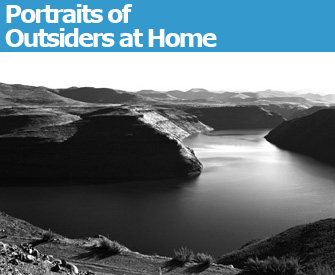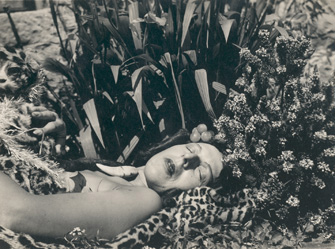 |
|
Santu Mofokeng’s “Katse Dam, Lesotho” (1996), from the photo essay “Landscape and Memory.” © Santu Mofokeng |
The Galerie du Jeu de Paume is holding exhibitions of the work of two photographers interested in alienation: the alienation of South African black people in their own country, and …
 |
|
Santu Mofokeng’s “Katse Dam, Lesotho” (1996), from the photo essay “Landscape and Memory.” © Santu Mofokeng |
The Galerie du Jeu de Paume is holding exhibitions of the work of two photographers interested in alienation: the alienation of South African black people in their own country, and the alienation of an individual who would rather not be herself.
“Santu Mofokeng, Chasseur d’Ombres: 30 Ans d’Essais Photographiques” presents 10 photo essays, consisting of over 200 images, by South African photographer Santu Mofokeng, some dating back to 1985 and others still in process. The exhibition is set up to show the evolution of the artist’s interests, with a growing emphasis on landscape and the links between landscape and memory. Mofokeng, who was born in 1956 in Johannesburg, began his career in the 1970s as a street photographer in Soweto, one of the most infamous South African townships. He then worked for Weekly and New Nation, two newspapers firmly opposed to apartheid.
The show starts with images focusing on the daily lives of black people in South Africa. The utter destitution of the hovels shown in the photos of some townships is appalling. Because of the ravages of AIDS, some orphaned children have to provide for their families. The difference in wealth between black and white people is subtly addressed in two pictures displayed side by side. In the first, young white men, all dressed in white, are playing cricket on a spotless pitch. In the second, black teenagers are playing golf in the middle of tall grass in what appears to be a wasteland.
Mofokeng’s intention, however, is not just to portray the townships as bleak and hopeless. He is anxious to show that beyond the unquestionable misery, there is life and often a lively spirituality. A recurring feature of his images is the seemingly omnipresent spirituality and religiosity among South African black people. In his 1986 “Train Church,” workers on a train are shown praying, singing, foot-stomping and hand-clapping. At first this daily ritual annoyed Mofokeng because it prevented him from resting on the train, but it soon began to intrigue him as further evidence of the pervasiveness of spirituality in his country. In “Chasing Shadows,” Mokofeng portrays the rituals of the Christian Zionic Apostolic Faith on Good Friday, when its members pray in caves, underlining the relationship between spirituality and nature. One photograph in this series, of an emaciated horse standing in front of eerie-looking trees, exemplifies the mingling of reality and unreality that characterizes many of his photos.
Mofokeng developed his interest in landscape with “Trauma Landscape” and “Landscape Memory,” two photo essays he started in 1996. He embarked on a quest to photograph places invested with history and memory, such as concentration camps and burial grounds from the Boer Wars, two wars fought in South Africa between the British Empire and Dutch settlers at the end of the 19th century. Hoping to find a way to embody the South African landscape, he traveled to places where black people were not allowed to go under apartheid. “Democratic South Africa is yet to take psychic ownership of the land it has inherited from the apartheid ancestor,” said Mofokeng, who then moved to Europe to visit Nazi concentration camps like Auschwitz and Ravensbrück and came back with dreadful pictures and mixed feelings. “I was looking for answers,” he said, “but all I found were shadows.”
The Galerie du Jeu de Paume is also holding an exhibition of the work of French photographer Claude Cahun (née Lucy Schwob, 1894-1954), who lived openly as a lesbian and moved in Surrealist circles, admired by the likes of
 |
|
“Self-portrait” (c. 1939) by Claude Cahun. © Jersey Heritage |
André Breton and Tristan Tzara. Cahun’s photos were never exhibited in her lifetime and were mostly unknown to the public before the 1980s.
Most of her work focuses on the ideas of metamorphosis and gender ambiguity. The photographs in the show are mainly self-portraits in which she is often disguised, whether as a man, the Buddha or an angel. She frequently appears with her head shaved, a provocation for a woman of her time.
The exhibition includes many of the self-portraits and photomontages of this artist whose “preferred role” was, in her own words, “imagining myself to be different from how I am.”
Galerie nationale du Jeu de de Paume: 1, place de la Concorde, 75008 Paris. Métro: Concorde. Tel.: 01 47 03 12 50. Open Tuesday-Friday, 12am-7pm; Saturday-Sunday, 10am-7pm, Tuesday until 9pm. Admission €8.50. Through September 25. www.jeudepaume.org
Please support Paris Update by ordering books from Paris Update’s Amazon store at no extra cost. Click on your preferred Amazon location: U.K., France, U.S.
Buy other music and books from the Paris Update store: U.K., France, U.S.
Reader Reaction: Click here to respond to this article (your response may be published on this page and is subject to editing).
© 2010 Paris Update
Favorite